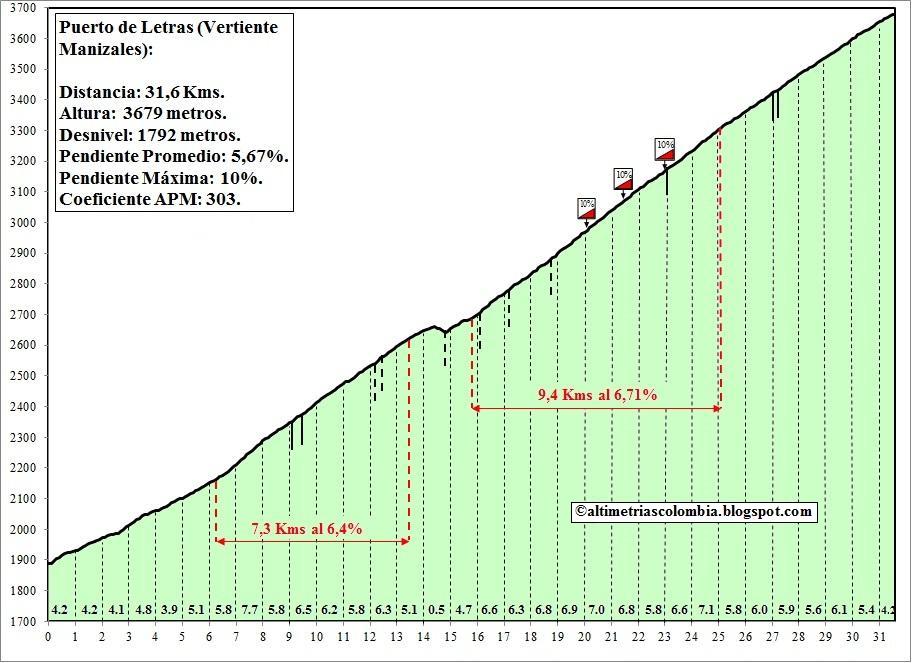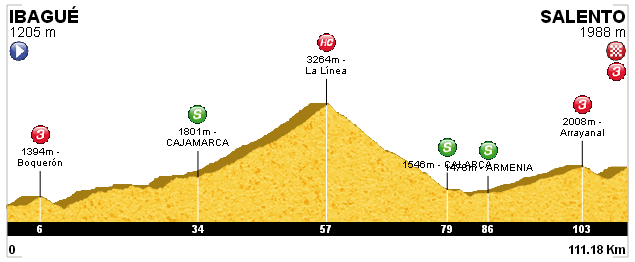The Clásico RCN, Colombia's second biggest traditional stage race, is underway today with a 27,4km team time trial. It's one of these national tours that isn't a national tour, in that it is essentially no different in
concept from the Vuelta a Colombia but is a sponsor concern, much like the Clásico Banfoandes in Venezuela, the Vuelta por un Chile Lider or the HTV Cup (although the latter is noticeably bigger than when the Tour of Vietnam actually ran). It therefore can run over any length and over any part of Colombia, though unsurprisingly the cycling-supportive regions of Antioquia and Boyacá feature most heavily and there's less pressure to visit as much of the country as possible.
This year's race will be brutal, taking in several of Colombia's biggest and baddest climbs over its 9-day duration.
Stage 2 will include the easy side of the Alto de Minas (cat.2) before a not-quite-summit finish at Jericó (2km after the Alto del Salvador):
Stage 3 features the cat.1 Alto del Descanso early on, but then a flat second half. Stage 4 is a mini-stage, Unipuerto up the Alto de Letras from Pereira. This is the easy side of the climb, but with the ultra-mythical Letras, this is a relative measure. They skip Manizales, the traditional finish of the Letras stage from Honda or Mariquita over the tougher east side, but that still means a lot of gradual climbing (including a cat.1 climb) before finishing with the final 23km of this:

For those disappointed at not using the monster eastern side of Letras, though, don't fear, the organisers have you covered. Stage 5 begins in Honda with 40km of flat roads to take us to the ruins of the town of Armero, destroyed in what is known as the Tragedia del Armero in 1985 when lahars from the Nevado del Ruíz volcano ravaged the town after poor communication and distribution rendered hazard maps and evacuation plans ineffective. Over 20.000 of the town's 29.000 inhabitants died, and the tragedy was spread around the world by the haunting photos of
Omayra Sánchez, a 13-year-old girl pinned in the wreckage and unrescuable, trapped up to her neck in the mud and with her eyes turned completely black from the pollution and chemicals in the volcanic debris, who nevertheless gave stoic interviews while the rescue teams tried unsuccessfully to find a way to extricate her from her fate. The rest of the stage, however, is less macabre, but will see the riders scale the eastern side of the mountain valleys through which the lahars plunged 36 years ago, up to the town of Murillo. This is a 56km climb at just under 5% with the final 21,5km at 6,5% so should be a brute.

Stage 6 is a straightforward flat stage with a false flat final few kilometres into traditional stage host Ibagué, common in both the Vuelta a Colombia and the Clásico RCN almost every year. This enables stage 7 to be a replica of a Vuelta a Colombia stage a few years ago, climbing the easier (again, relatively speaking, as 23km at 6,1% is more than an adequate challenge) side of the Alto de la Línea at around the halfway point of the stage before descending and then a short, punchy climb into Salento:
Overall, it's an almost exact replica of a stage designed by Gustavo Duncan and Asier Bilbao at Altimetrias Colombia, but with a longer run between La Línea and the summit finish as the Clásico RCN avoids the Arrayanal climb in between:
Stage 8, like stage 3, features an early cat.1 climb but then a long and gradual descent before a flat run-in. Stage 9 is a 20km ITT.
22 teams are entered, 21 being Colombian and one Costa Rican squad. As ever the main men to beat will be Team Medellín. They won the opening TTT with a 5" advantage over EPM, 26" over Colombia Terra de Atletas, and 32" over Orgullo Paísa, their fellow Antioquians. Their sextet making it to the line together was evergreen babyface Óscar Sevilla (who takes the leader's jersey), defending champion José Tito Hernández, Robinson Chalapud, Fabio Duarte, Brayan Stíven Sánchez and Robigzon Oyola, while riders dropped include Cristhian Montoya and Bernardo Suaza, so they are brutally strong. Other contenders will be Juan Pablo Suárez, Freddy Montaña and Aldemar Reyes for EPM, Didier Merchán and Darwin Atapuma for CTA, Daniel Jaramillo for Orgullo Paísa, George Tibaquirá for EBSA, Rubén Dario Acosta and Rafael Steven Pineda for Strongman, Didier Chaparro for Supergiros, Javi Jamaica for CM, Rodolfo Torres for Fundecom.
There are a few moonlighters too - Yesid Pira who excited people so much in the Vuelta and has been racing in Europe with the Caja Rural amateur setup (turns pro with them for 2022) is here with Team Camacho, while César Paredes, who usually plies his trade for Loulé in Portugal, is here with JB-Flowerpack, a team I know nothing about. However they could be intriguing as they also have Mr 63%, Jimmi Briceño, in from Venezuela. Herrera Sport are also somewhat makeshift, featuring moonlighting Peruvian star Royner Navarro and 2020 Vuelta a Guatemala winner Mardoqueo Vásquez. GW-Sistecredito also have Jeison Rujano, son of José, in their lineup. However, 2/3 of the Vuelta a Colombia podium will not be here - Alex Gil suffered a bad injury after a crash in the Vuelta a Antioquia in September, while Aristobulo Cala is provisionally suspended. Still, it's otherwise a really strong lineup and TV coverage is out there with Antena2 broadcasting it live for streaming, so this should be a fun one.










